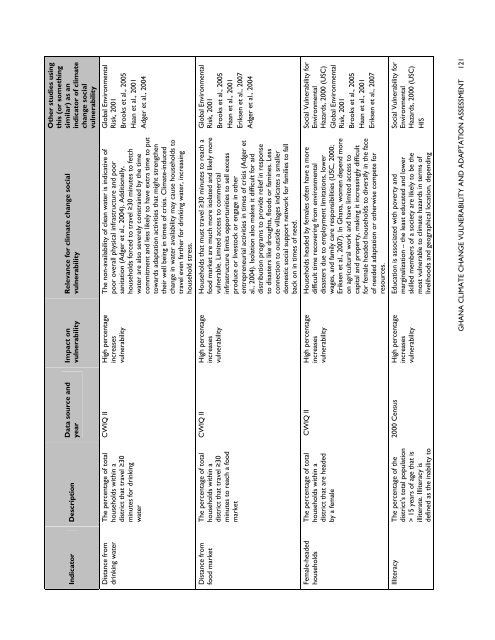ghana climate change vulnerability and adaptation assessment
ghana climate change vulnerability and adaptation assessment
ghana climate change vulnerability and adaptation assessment
- No tags were found...
Create successful ePaper yourself
Turn your PDF publications into a flip-book with our unique Google optimized e-Paper software.
Indicator DescriptionDistance fromdrinking waterThe percentage of totalhouseholds within adistrict that travel ≥30minutes for drinkingwaterDistance fromfood marketThe percentage of totalhouseholds within adistrict that travel ≥30minutes to reach a foodmarketFemale-headedhouseholdsThe percentage of totalhouseholds within adistrict that are headedby a femaleIlliteracy The percentage of thedistrict’s total population> 15 years of age that isilliterate. Illiteracy isdefined as the inability toData source <strong>and</strong>yearImpact on<strong>vulnerability</strong>CWIQ II High percentageincreases<strong>vulnerability</strong>CWIQ II High percentageincreases<strong>vulnerability</strong>CWIQ II High percentageincreases<strong>vulnerability</strong>2000 Census High percentageincreases<strong>vulnerability</strong>Relevance for <strong>climate</strong> <strong>change</strong> social<strong>vulnerability</strong>The non-availability of clean water is indicative ofpoor overall physical infrastructure <strong>and</strong> poorsanitation (Adger et al., 2004). Additionally,households forced to travel ≥30 minutes to fetchwater are also severely constrained by the timecommitment <strong>and</strong> less likely to have extra time to puttowards <strong>adaptation</strong> activities that might strengthentheir well being in times of crisis. Climate-induced<strong>change</strong> in water availability may cause households totravel even farther for drinking water, increasinghousehold stress.Households that must travel ≥30 minutes to reach afood market are much more isolated <strong>and</strong> likely morevulnerable. Limited access to commercialinfrastructure limits opportunities to sell excessproduce or livestock or engage in otherentrepreneurial activities in times of crisis (Adger etal., 2004). Isolation also makes it difficult for aiddistribution programs to provide relief in responseto disasters like droughts, floods or famines. Lessconnection to outside villages indicates a smallerdomestic social support network for families to fallback on in times of need.Households headed by females often have a moredifficult time recovering from environmentaldisasters due to employment limitations, lowerwages, <strong>and</strong> family care responsibilities (USC, 2000;Eriksen et al., 2007). In Ghana, women depend moreon agricultural work <strong>and</strong> have limited access tocapital <strong>and</strong> property, making it increasingly difficultfor female headed households to diversify in the faceof needed <strong>adaptation</strong> or otherwise compete forresources.Education is associated with poverty <strong>and</strong>marginalization – the least educated <strong>and</strong> lowerskilled members of a society are likely to be themost vulnerable to <strong>climate</strong> hazards in terms oflivelihoods <strong>and</strong> geographical location, dependingOther studies usingthis (or somethingsimilar) as anindicator of <strong>climate</strong><strong>change</strong> social<strong>vulnerability</strong>Global EnvironmentalRisk, 2001Brooks et al., 2005Haan et al., 2001Adger et al., 2004Global EnvironmentalRisk, 2001Brooks et al., 2005Haan et al., 2001Eriksen et al., 2007Adger et al., 2004Social Vulnerability forEnvironmentalHazards, 2000 (USC)Global EnvironmentalRisk, 2001Brooks et al., 2005Haan et al., 2001Eriksen et al., 2007Social Vulnerability forEnvironmentalHazards, 2000 (USC)HISGHANA CLIMATE CHANGE VULNERABILITY AND ADAPTATION ASSESSMENT 121
















